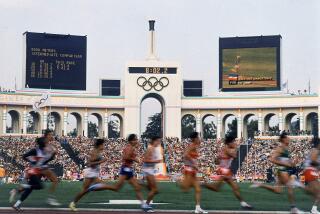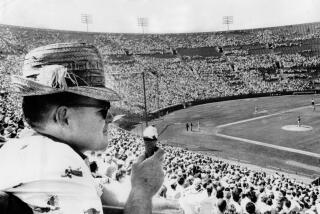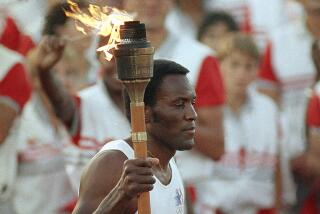This Old Haunt : Olympic Club Has Been a Victory Graveyard for Some of Golfâs Biggest Names
SAN FRANCISCO â All anyone needs to know about the Olympic Club, the site of this weekâs U.S. Open, is that three other Opens have been staged at the woodsy layout, the San Andreas fault spreads its finger underneath it and itâs the place where Jack Fleck won instead of Ben Hogan in 1955, Billy Casper won instead of Arnold Palmer in 1966 and Scott Simpson won instead of Tom Watson in 1987.
Clearly, Olympic is always ready to rumble.
Yes, we are talking about golf here and, yes, anything can happen, but so do train wrecks, bills and audits, in real life. The fact remains that the big question when they tee it up Thursday for the first round of the 98th U.S. Open is if weâre talking about a trend at Olympic.
Is this place haunted or what?
Look what happened to Hogan, Palmer and Watson. After losing at the Olympic, none of them won a major afterward. Youâve got to hand it to the place. Olympic has earned itâs nickname: âGraveyard of Champions.â
There may be a better chance that a caddie will get lost in the rough than an actual representative of golfâs hierarchy will win the Open at Olympic. In these Olympic games, the golf course symbol could very well be interlocking rings. Only here, theyâre handcuffs.
And so the Olympic Club enjoys a brief, but quirky, history as a hero-killer, where legends are unmade, dreams dashed and asterisks hang from the results like the Spanish moss that drapes the trees that hug the fairways.
To appreciate a golf course, itâs a good idea to know a little something about the major championships that have been staged there. Consider this an Olympic Moment. All right, so there are three of them, but theyâre sort of alike, so donât get confused. Not for a moment. This place is confusing enough.
1955: Hoganâs De-Fleck-ted
It should have been Hoganâs fifth Open title, a legendary golfer bagging yet another major championship in a legendary career. Hogan made par on the 72nd hole to finish at 287 and just about everybody at Olympic was as convinced that Hogan had won as television announcer Gene Sarazen, who congratulated Hogan just as NBC went off the air announcing Hogan as the winner.
Meanwhile, back at the 14th tee, was Fleck, a 33-year-old municipal course pro from Davenport, Iowa, who was one shot behind, even if no one was paying attention to this nobody.
Why should anyone? Fleck had played 41 other tournaments and won a total of less than $7,500. Whatâs more, he hadnât been able to break 80 in his practice rounds.
Fleck began his charge, oddly, with a bogey at No. 14 and there wasnât a sound from his small gallery.
âI remember thinking âGoodness sakes, they must think Iâm all through,â â said Fleck, 75, who lives near Magazine, Ark.
He was not. Fleck birdied the par-three 15th, made par on the next two holes and then, to the surprise of absolutely everyone, caught Hogan with a birdie on the 18th. Fleck hit a seven-iron for his second shot and the ball stopped seven feet from the hole, from where he rolled in the putt to catch Hogan and force a playoff the next day.
It was predicted that Hogan vs. Fleck would be the greatest mismatch in U.S. Open history. It wasnât. After 17 holes, Fleck led by a shot and made par. Hogan snap hooked his drive into the rough, took three shots to get out and made double bogey.
Fleck made history. Unexpected history, but still history. Fleck says there is nothing fluky about his victory from 42 years ago.
âThere I was. I beat Ben Hogan, and Snead was five shots back. Does that say anything?â
Can anyone else hear the word âOlympic?â
One other quirky footnote: Fleck was breaking in a new set of clubs that week. The new Hogan signature series.
1966: Palmer Sees Ghost
Has anyone blown a seven-shot lead with nine holes to play to lose a major championship? There is one.
Palmer managed to do it on the last day at Olympic, then lost an 18-hole playoff to Billy Casper the next day and lost his chance for a second U.S. Open title.
The enormity of it all is almost overwhelming. A seven-shot lead with nine holes to go? At least Palmer managed to do it in spectacular fashion.
Casper told Palmer as they made the turn that he was hoping to finish second. Palmer understandably thought he had the Open in his pocket, so he turned his attention to beating Hoganâs 72-hole record score of 276. As it turned out, this was not a very good idea.
Palmer hooked his drive on No. 10 and made bogey. He got the shot back when he birdied No. 12, but the fact is that the Olympic Club was closing in fast, its usual bad vibes bouncing off the trees and collecting inside Palmerâs cardigan sweater.
Palmer bogeyed the 13th, went for the flag at the par-three 15th to try to stay within sight of the record, but wound up in a bunker. After Casper made his second birdie on the back nine and Palmer missed his par putt, the lead was down to three with three holes left.
Palmer hooked his tee shot at the 16th and made a bogey while Casper birdied. The lead was one.
At the 17th, Palmer made his fourth bogey on the back, Casper made par and the lead was gone. In the playoff the next day, Palmer led by two at the turn, but bogeyed 11, 14, 15 and double-bogeyed 16. He shot 73 and lost to Casper by four shots.
It was the third time Palmer lost an Open playoff. But his losses in 1962 and 1963 didnât have the flair this one did, which Palmer points out, to his credit.
âHell, I made a birdie on the 12th hole and I still lost seven shots. Thatâs pretty dramatic.â
As for Casper, it was his second U.S. Open victory--he also won in 1959--but this one was virtually gift-wrapped and hand-delivered by Palmer. Casper said it sort of fell into his lap, which was a lot smaller target than before since he had dropped about 50 pounds in two years.
âI felt a great feeling for him and what he had gone through,â Casper says. âI could really relate to [Nick] Faldo hugging [Greg] Norman at the Masters. Beating someone by a shot is not the same as being there when they kick it away.â
This time, Palmer was in punt formation and the field was the Olympic Club.
1987: Watson Says Dâoh!
At that point in his career, 31-year-old Scott Simpson was best known for rooming with Craig Stadler at USC, if you donât count his three previous PGA Tour victories.
Simpson had missed the cut at the 1986 U.S. Open and probably was more of a threat to have his prematurely gray hair turn completely white before the tournament was over than to actually win it.
Besides, Jack Nicklaus was in contention, one shot out of the lead after two rounds, trailing Watson and Mark Wiebe. By now, there werenât too many who didnât realize the Olympic experience and how it crushed the big names, so the smart ones were curious to see how Nicklaus and Watson would falter.
Nicklaus went first, shooting a 76 on Saturday and a 77 on Sunday. Watson went later, but it wasnât his fault. Blame Simpson, who caught Watson on the 14th hole of the last round. Simpson birdied the 14th with a six-foot putt, knocked an eight-iron to 25 feet and made the putt on the 15th and birdied the 16th after he hit a nine-iron to 15 feet.
It was then that Simpson knew something special was up. He didnât know it until then because he refused to look at the scoreboard before.
âI realized I was leading at that point,â he said.
Watson missed a 12-foot birdie putt at the 16th, Simpson saved par after bunkering his second shot at the 17th and Watson got his own shaky par at the 17th. He needed to close with a birdie to catch Simpson, but his second shot wedge came up short and spun back 35 feet from the hole. He missed the putt, but just barely.
After another unlikely hero held up the U.S. Open trophy at the Olympic Club, Watson said he should have hit nine-iron instead of wedge on the last hole. So why didnât he? Maybe it was Olympic, whispering in his ear or maybe that was just a breeze blowing through the trees, stirring the leaves, turning the place a bit colder. Thatâs what happens this time of year.
More to Read
Go beyond the scoreboard
Get the latest on L.A.'s teams in the daily Sports Report newsletter.
You may occasionally receive promotional content from the Los Angeles Times.






